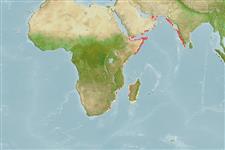Classification / Names
Common names | Synonyms | Catalog of Fishes (gen., sp.) | ITIS | CoL | WoRMS | Cloffa
Actinopterygii (ray-finned fishes) >
Anguilliformes (Eels and morays) >
Ophichthidae (Snake eels) > Ophichthinae
Etymology: Ophichthus: Greek, ophis = serpent + Greek, ichthys = fish (Ref. 45335); ishiyamorum: Named for Nelson and Patsy Ishiyama.. More on author: McCosker.
Environment / Climate / Range
Ecology
Marine; benthopelagic; depth range 258 - 400 m (Ref. 84366). Deep-water, preferred ?
Off the Gulf of Aden, Somalia.
Size / Weight / Age
Maturity: Lm ? range ? - ? cm
Max length : 43.7 cm TL male/unsexed; (Ref. 84366)
Short description
Morphology | Morphometrics
Vertebrae: 130 - 132. This stout species of Ophichthus, subgenus Coecilophis is distinguished by the following characters: tail 52-55% and head 14-15% of total length; origin of dorsal-fin in front of pectoral-fin base; wedge-shaped pectoral fins; posterior nostril in upper lip is covered by a flap; inconspicuous head pores, SO 1+4, IO 4+2, POM 3+7-9; small, conical and widely-spaced teeth, nearly uniserial on vomer and jaws; uniform tan in color, fins pale; mean vertebral formula 15/50/131, total vertebrae 130-132 (Ref. 84366).
Life cycle and mating behavior
Maturity | Reproduction | Spawning | Eggs | Fecundity | Larvae
McCosker, J.E., 2010. Deepwater Indo-Pacific species of the snake-eel genus Ophichthus (Anguilliformes: Ophichthidae), with the description of nine new species. Zootaxa 2505:1-39. (Ref. 84366)
IUCN Red List Status (Ref. 115185)
CITES (Ref. 94142)
Not Evaluated
Threat to humans
Harmless
Human uses
More information
Common namesSynonymsMetabolismPredatorsEcotoxicologyReproductionMaturitySpawningFecundityEggsEgg development
Age/SizeGrowthLength-weightLength-lengthLength-frequenciesMorphometricsMorphologyLarvaeLarval dynamicsRecruitmentAbundance
ReferencesAquacultureAquaculture profileStrainsGeneticsAllele frequenciesHeritabilityDiseasesProcessingMass conversion
Tools
Special reports
Download XML
Internet sources
Estimates of some properties based on models
Phylogenetic diversity index (Ref.
82805): PD
50 = 0.5000 [Uniqueness, from 0.5 = low to 2.0 = high].
Bayesian length-weight: a=0.00151 (0.00061 - 0.00373), b=2.91 (2.70 - 3.12), in cm Total Length, based on LWR estimates for this (Sub)family-body shape (Ref.
93245).
Trophic Level (Ref.
69278): 3.8 ±0.7 se; Based on size and trophs of closest relatives
Resilience (Ref.
69278): High, minimum population doubling time less than 15 months (Preliminary K or Fecundity.).
Vulnerability (Ref.
59153): Low to moderate vulnerability (27 of 100) .
